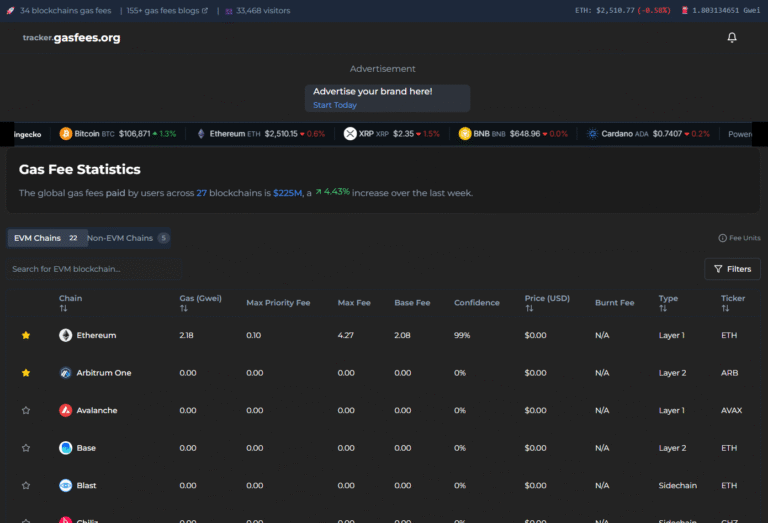
What Are Avalanche Gas Fees?
In the realm of blockchain technology, Avalanche has been making waves with its unique consensus mechanism, promising high throughput and low transaction fees.
At the heart of this groundbreaking technology lies Avalanche gas fees, which play a pivotal role in facilitating efficient transactions on the Avalanche blockchain.
Understanding Avalanche Gas Fees
Before diving into the details of Avalanche gas fees, let’s establish a foundational understanding of the concept. Gas fees are transaction fees incurred by users when they interact with a blockchain network.
These fees serve two primary purposes: compensating network validators for processing transactions and acting as a deterrent against spam or abusive usage of the network.
Avalanche: A Unique Blockchain Ecosystem
Avalanche is known for its innovative consensus mechanism, offering a distinct advantage in terms of scalability and efficiency. Its architecture, based on the Avalanche protocol, utilizes a network of validators to reach consensus.
This unique approach allows Avalanche to process transactions with lightning speed while maintaining security.
Avalanche Gas Fees Unveiled
Avalanche gas fees, as the name suggests, are the transaction fees associated with the Avalanche blockchain. These fees are essential for ensuring the smooth operation of the network and are crucial for various blockchain activities, including transferring assets, executing smart contracts, and interacting with decentralized applications (DApps).
Advantages of Avalanche Gas Fees
- Low Transaction Costs: One of the most notable advantages of Avalanche gas fees is their affordability. Due to the innovative consensus mechanism, transactions on the Avalanche blockchain are remarkably cost-effective, making it an attractive choice for users seeking to avoid high fees often associated with other blockchains.
- High Throughput: Avalanche’s ability to process thousands of transactions per second contributes to its low gas fees. The efficient consensus protocol ensures that transactions are confirmed swiftly, eliminating the congestion-related fee spikes seen on some other blockchains.
- Scalability: Scalability is a cornerstone of Avalanche’s design. Its dynamic validator set and subnets architecture enable the network to scale efficiently, further reducing the likelihood of congestion and high gas fees during peak usage.

Determining Avalanche Gas Fees
Several factors influence the calculation of Avalanche gas fees:
- Network Demand: As with most blockchain networks, the level of network demand plays a crucial role in determining gas fees on Avalanche. During times of high demand, gas fees may increase slightly, although they generally remain low compared to other blockchains.
- Transaction Complexity: The complexity of a transaction or smart contract execution impacts the gas fee. More intricate operations consume more computational resources and, consequently, may incur higher fees.
- Gas Limit: Users can set a gas limit for their transactions, representing the maximum amount of gas they are willing to consume. Transactions reaching this limit without completion may still incur fees.
The Role of Gas Price
In addition to gas fees, Avalanche users can specify a gas price when submitting transactions. The gas price represents the amount a user is willing to pay per unit of gas consumed. Validators prioritize transactions with higher gas prices, ensuring that they are processed promptly.
Impact on Decentralized Applications (DApps)
Avalanche’s low gas fees have significant implications for the world of decentralized applications (DApps). DApp developers and users benefit from the efficient and cost-effective environment offered by the Avalanche blockchain. Here’s how:
- Enhanced User Experience: Users of Avalanche-based DApps enjoy seamless interactions with minimal transaction costs. This improved user experience can drive greater adoption of decentralized applications.
- Cost-Efficient Development: DApp developers appreciate the reduced cost of deploying and executing smart contracts on Avalanche. Lower gas fees translate into more affordable development and testing processes.
- Attractive to DeFi: Decentralized finance (DeFi) projects, which often involve frequent transactions and interactions with smart contracts, find Avalanche’s low gas fees particularly appealing. Users can engage in DeFi activities without the burden of high transaction costs.
Strategies for Managing Avalanche Gas Fees
While Avalanche gas fees are generally low, it’s still essential for users to manage them effectively, especially during periods of high demand. Here are some strategies for optimizing your Avalanche gas fee experience:
- Gas Price Optimization: Set an appropriate gas price based on your transaction’s urgency. Lower gas prices may lead to slightly slower processing times but can result in cost savings.
- Off-Peak Transactions: Whenever possible, perform transactions during periods of lower network activity. This can help you avoid congestion-related fee increases.
- Gas Limit Setting: Carefully set the gas limit for your transactions, ensuring it aligns with the complexity of the operation. Avoid unnecessarily high gas limits to minimize costs.
- Batch Transactions: If you have multiple transactions to perform, consider batching them together. This can reduce the overall gas fees incurred.
The Future of Avalanche Gas Fees
As the Avalanche blockchain continues to evolve and attract more users and developers, the issue of gas fees remains a critical consideration. The development community is actively exploring various solutions to further enhance scalability and reduce gas fees even further, ultimately aiming to provide an even more cost-effective and efficient blockchain experience.
In the ever-evolving world of blockchain technology, Avalanche stands out for its groundbreaking consensus mechanism and low-cost transaction model.
Avalanche gas fees play a vital role in facilitating this efficiency, offering users an affordable and scalable blockchain experience. As blockchain adoption continues to grow, understanding and optimizing gas fees, especially on innovative platforms like Avalanche, is key to maximizing the benefits of decentralized applications and financial transactions.
With low gas fees and high throughput, Avalanche is poised to remain a strong contender in the blockchain ecosystem, paving the way for a more accessible and user-friendly decentralized future.
More Blogs
Comprehensive articles, guides, and tutorials on how gas fees work, why they fluctuate, and strategies to manage them effectively.





